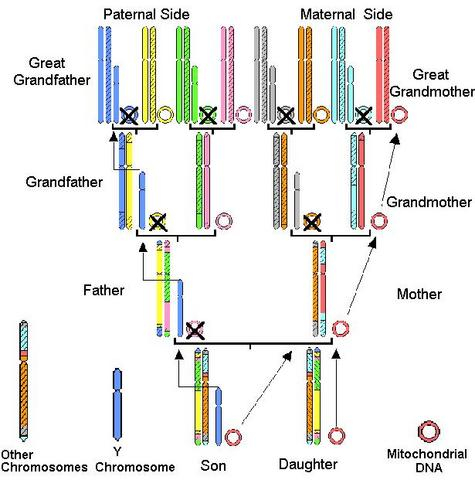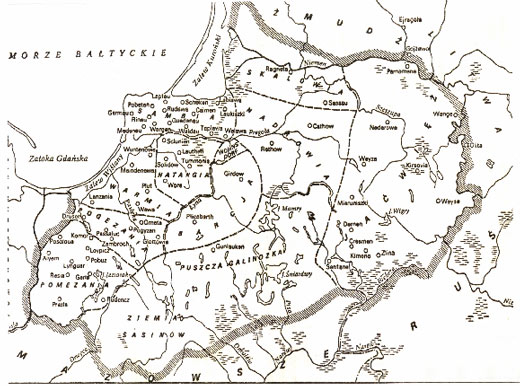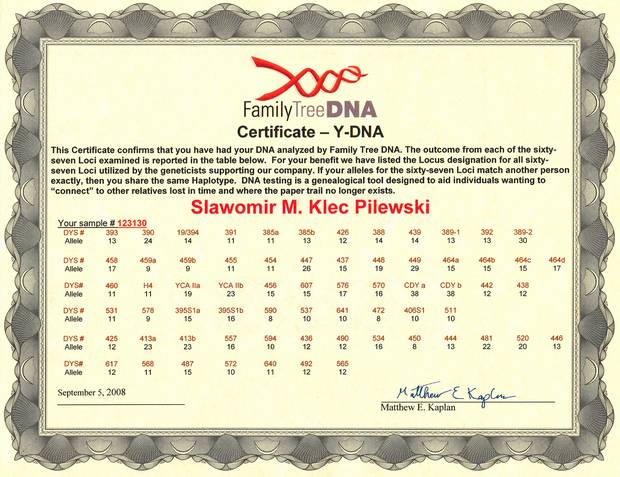In the last couple of years tremendous progress has been made
in human genetic genealogy. Among other findings, the secret of genetical genealogy
which all of us possess through DNA. This secret is coded in our DNA, research
in a specific laboratory can reveal to what specific ethnic group we belong.
An archeologist can reveal functions of a past and lost culture. DNA results reveal
your closest relatives, no matter how far or nationality, going back hundreds or
even thousands of years.
Findings are based on scrapings from your mouth and given
to a specific laboratory for processing and conclusions. Studies of 12 markers, from
your mouth scraping, reveal to what ethnic group one belongs, 37 markers will reveal
your closest relatives, and 67 markers , will confirm and closely identify earlier findings.

Checking ones chromosome Y, belonging only to men and passed from father to son,
is revealed by light blue colour in the above illustration.
Genetic findings in regards to the Pilewski‘s revealed that our haplogroup is R1b1b2.
What does it mean? Prehistorically we belong to a subgroup that
had its beginning 32 000 - 21 000 years before Christ. About the year 12 000 before
Christ this group colonized the North-West part of Europe from the Iberian peninsula
to Scandinavia. Probably they came to pre-historic Europe through the Black Sea
and the Baltic from Ukraine or Kazakhstan.
From the year 1490
before Christ , the southern coast from the Baltic, Pomerania, Prussia also Masovia,
as well as Scandinavia, were witnesses to settlements and constant movement in and out by the Gott people.
Baltic Gotts are Ostrogotts who at at the end of the fifth
century conquered Rome. To indicate the close relation the Prussians had with the
Ostrogott king of Rome Teodoricus the Great from Ravenna, they had an audience with
the king in year 525, many of them brought him gifts of Amber.
Prussian territory was partially inhabited by the Gotts,
who were called Gepids or Gepedoios. They bordered next to Vidiwarians, a mixture
of gottic-anciant Slavs. Further East and along the Baltic were the Ugro-Finns.
Genetic findings revealed that the Lithuanians 43% of those checked, belonged to the haplogroup

of Ugro-Finns, and the remainder were Slavic people.
One can expect that further findings will reveal that the
Prussians were not an ethnic uniform group, in other words one nation.
One can conclude that Prussians were a commonwealth of many people.The only question is,
the question of their language or languages through which the Prussians were able
to communicate with each other. Galinds and Sasins for sure were also Gotts.
During the conquest by Teutons, there were not many left on their territory.
The land of our forbearers Pomezania and for sure Pogezania were inhabited by the
Gepids and partially by the Vidiwarians people. Thanks to genetic research there was a
connection with others who took part in the DNA project. This revealed that Pilewski‘s
have distant relatives in Scandinavia, Scotland, Ireland, France, Spain and England.
Two persons who allowed themselves to be checked demonstrated that they were very close
to us. Our mutual forbearers lived 500-600 years ago. As the project of YDNA advances for
sure there will be a lot of positive findings and surprises.
 R1b1b2-a1b Marker DNA
Back to Top »
R1b1b2-a1b Marker DNA
Back to Top »
